
CENBIO - Enabling sustainable and cost-efficient bioenergy in Norway
SP5 - Knowledge transfer and innovation
The main purposes of SP5 are:
- The development of educational structures to train the next generation of bioenergy researchers,
- To enhance the communication about CenBio activities both at scientific level, and to the general population,
- The management of the CenBio innovations to better support the development of the bioenergy industry.
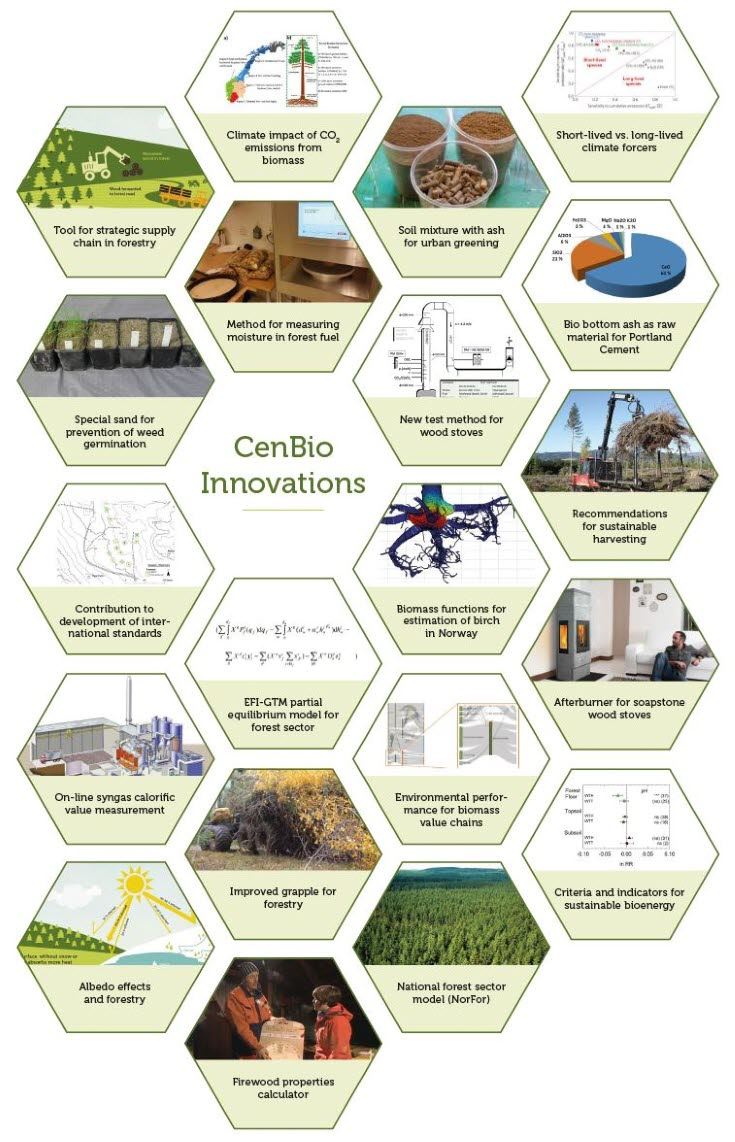
WP5.1 - Bioenergy Graduate School
One of the major tasks for the Bio-Energy Graduate School is to promote studies in bioenergy. Now both NMBU and NTNU are running master and PhD courses in bioenergy on a regular basis based on an initiative from CenBio, as described in the Appendices. Eight master students performed their Master Thesis within CenBio activities in 2015. CenBio has actively sought collaboration with other Graduate Schools in Norther Europe and links have been made both to Cecost Graduate School (Swedish Centre for Combustion Science and Technology) as well as the Nordic Five Tech (N5T) Alliance.
33 PhD candidates have been affiliated with CenBio up to 2016. So far, joint PhD courses in bioenergy have not been developed. However, planning has started for a common course portfolio where also external courses will be advertised. This work has been extended in 2016, and aims to be sustainable also after the Centre's project time. The level of the PhD candidates affiliated is sufficiently high so that they actively participate in CenBio's workshops as any other researcher.
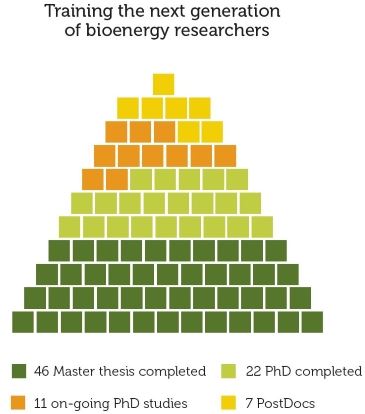
More information on the Bioenergy graduate school can be found here.
WP5.2 Knowledge transfer and dissemination
Deliverables
All results from both management and research activities within CenBio are documented in Deliverables (requires login and password), whether they are public or for internal distribution only. Most public documents can be found on our website in Publications.
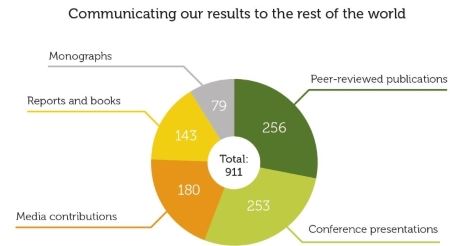
One of the overall targets for CenBio was to deliver 150 international publications, of which 75 in peer-reviewed journals. The figure below shows the current status of the publications in peer-reviewed journals, well beyond our primary target. The full list of journal publications can be found here.
CenBio researchers are also present at international conferences, and CenBio researchers regularly appear in the media.
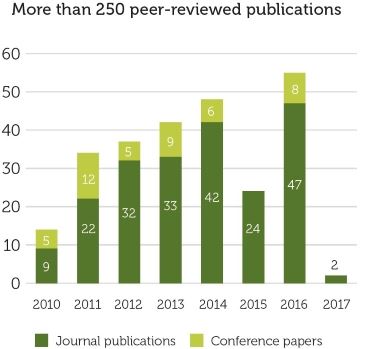
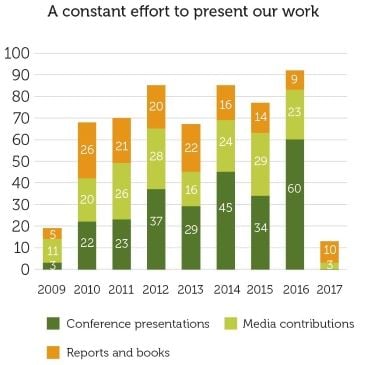
WP5.3 Innovation Management
New technological developments and innovations are crucial in order to reach the national goal of doubling the use of bioenergy within 2020. Innovation is an important part of the CenBio project with a quantified target of 25 completed innovations. The activities in this work package ensure that innovation is an integrated part of CenBio.
It was essential to establish a common understanding of innovation and how to implement the innovation activity in CenBio. This issue has been discussed in the three innovation workshops, which were arranged in 2010, 2011 and 2013. A CenBio definition of innovation has been approved, and innovation is included as a guiding star in the annual work plans.
The "List of innovations" (see table below) includes more than 35 potential innovations that are identified by now, and we are working systematically to develop these. In this context, patenting and publishing processes are an important issue that has been considered in a separate deliverable.
Twenty innovations have so far been completed and fully implemented.
A few examples are detailed below:
- Afterburner for woodstoves meeting the Norwegian environmental requirements, in close collaboration with the User partner Norsk Kleber AS.
- New test method for wood stoves. It is time-saving (25-50%) compared to existing methods and also cost-saving. This is highly relevant for the wood stoves user partners such as Jøtul AS.
- Knowledge developed on the importance of albedo for climate and forest management as well as policy development.
- Internationally- and UN-admitted demonstration that CO2 from biomass has lower climate impact than from fossil fuels.
- Ash utilization as a commercial product 1: Special sand designed to give no germination of weeds, licensed to Asak Miljøstein AS.
- Ash utilization as a commercial product 2: Soil mixture for urban greening, based on ash from the user partner Akershus Energi AS, licensed to Herremyr Gård AS.
- Method for on-line syngas calorific value measurement that allows continuous monitoring is developed by Energos AS and equipment is installed at a commercial plant.
- Firewood calculator. A new method is developed that sets the prize of firewood based on energy content which is the parameter of interest for the customer, instead of volume which has been the previous/current practice.
- Bio bottom ash as raw material for manufacturing of Portland Cement is a concept developed that will stretch the raw material resources (calcium carbonate) and reduce the cement plant CO2 emissions.
- Spreadsheet tool for strategic supply chain configuration for comparison of the economic performance of different supply chain configuration alternatives for wood chip supply.
- New knowledge is developed on the distinction between climate impact characteristics and degree of reversibility for short-lived vs. long-lived climate forcers.
Bioenergy Innovation Awards
CenBio has introduced the “Bioenergy Innovation Award” (BIA), a nationally-advertised innovation award within stationary bioenergy. This award was established to stimulate and reward knowledge based innovation and entrepreneurship, and to contribute to identify projects with innovation potential as well as enhance the focus on innovative thinking and activities within the bioenergy field. Bioenergy Innovation Award also contributes to put the focus on innovation-driven activities in CenBio and stimulates the enthusiasm to explore and realize new ideas.
In 2011, the first BIA awarded SINTEF Research Scientist Edvard Karlsvik for his innovative work with combustion technology for residential woodstoves.
In 2012, the second BIA awarded Cambi AS, one of the CenBio partners, for their innovative biogas production process for biomass from waste and sewerage, which is implemented in many plants world-wide.
The winner in 2013 was Sølor Bioenergi, exclusively using contaminated timber as energy source in their 10 MW combined heat and power (CHP) plant.
In 2014 the winner was Mjøsen Skog SA, having developed and implemented the ALLMA system, the first web-based GIS-system in Norway integrating up-to-date forestry plans with operative logistical functions.
The winner in 2015 was Vincent Eijsink, NMBU, for his work within the field of enzyme technology and biogas processes. His scientific research group has an international reputation and are exceptional good at linking basic scientific research and industrial interests.
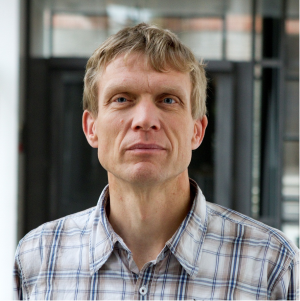
|
The winner of Bioenergy Innovation Award 2015 was Vincent Eijsink (NMBU).(Photo:NMBU) |
The BIA 2016 was awarded on Tuesday 7 June to Antec Biogas. The prize was announced at a workshop organised by CenBio during the 24th European Biomass Conference and Exhibition (EUBCE 2016). The jury wrote that the company "represents a possible paradigm shift in the production of biogas". Other news articles can be found here: gemini.no, and VVS Aktuelt.
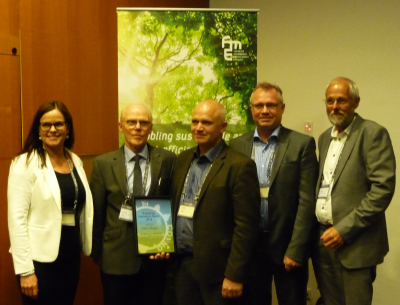
|
From left: Marie Bysveen (SINTEF/CenBio), Trond Værnes (RCN), Uno Andersen (Antec Biogas), Egil Andersen (Antec Biogas) og Odd-Jarle Skjelhaugen (NMBU/CenBio). (Photo: Michaël Becidan/CenBio) |
The winner of the BIA 2017 was Prediktor Intruments AS. They have developed the Spektron Biomass Analyzer, an instrument based on near-infrared (NIR) technology that is capable of measuring moisture content in forest fuels under variable environment conditions, including freezing temperatures. The fast, accurate method represents a significant improvement over the standard method which can take up to 24 hours. The committee commented that this innovation will contribute to the professionalisation of the bioenergy industry and have a major impact on the bioenergy value chain.
CenBio has had a fruitful cooperation with FME CenSES (Centre for Sustainable Energy Studies) including their actively involvement in the CenBio workshops as well as CenSES Master and PhD students studying the interaction between the research and user partners in the FME. Based on the results from this work, the emphasis on how to increase the value-creation for the user partners, based on CenBio results, has been intensified.